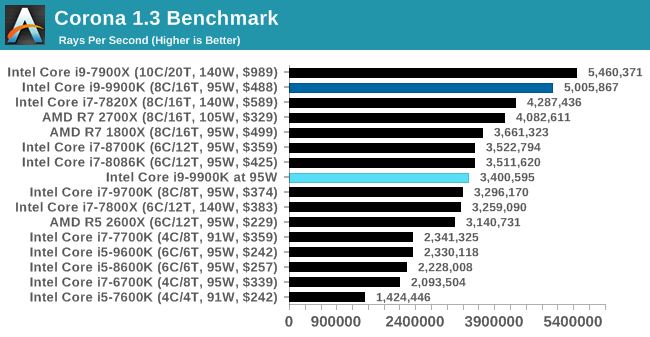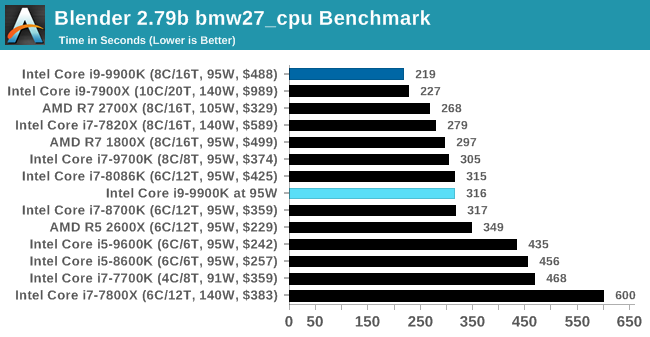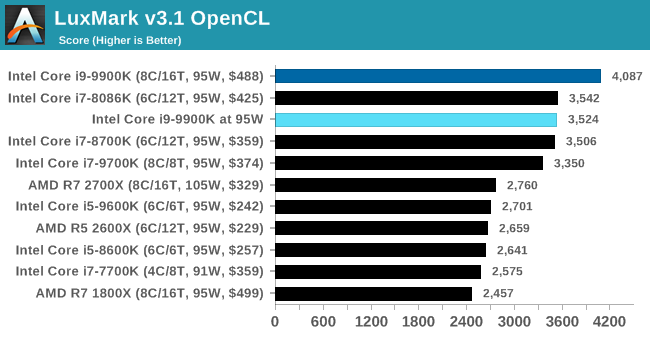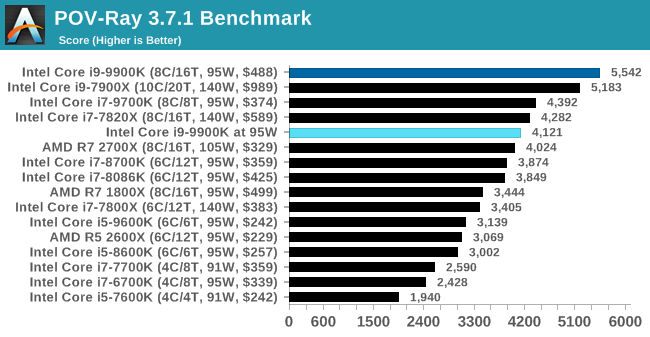The Intel Core i9-9900K at 95W: Fixing The Power for SFF
by Ian Cutress on November 29, 2018 8:00 AM ESTCPU Performance: Rendering Tests
Rendering is often a key target for processor workloads, lending itself to a professional environment. It comes in different formats as well, from 3D rendering through rasterization, such as games, or by ray tracing, and invokes the ability of the software to manage meshes, textures, collisions, aliasing, physics (in animations), and discarding unnecessary work. Most renderers offer CPU code paths, while a few use GPUs and select environments use FPGAs or dedicated ASICs. For big studios however, CPUs are still the hardware of choice.
All of our benchmark results can also be found in our benchmark engine, Bench.
Corona 1.3: Performance Render
An advanced performance based renderer for software such as 3ds Max and Cinema 4D, the Corona benchmark renders a generated scene as a standard under its 1.3 software version. Normally the GUI implementation of the benchmark shows the scene being built, and allows the user to upload the result as a ‘time to complete’.
We got in contact with the developer who gave us a command line version of the benchmark that does a direct output of results. Rather than reporting time, we report the average number of rays per second across six runs, as the performance scaling of a result per unit time is typically visually easier to understand.
The Corona benchmark website can be found at https://corona-renderer.com/benchmark

When we apply a full-fat rendering test, the 9900K at 95W scores around the i7-9700K which is a similar CPU with no hyperthreading.
Blender 2.79b: 3D Creation Suite
A high profile rendering tool, Blender is open-source allowing for massive amounts of configurability, and is used by a number of high-profile animation studios worldwide. The organization recently released a Blender benchmark package, a couple of weeks after we had narrowed our Blender test for our new suite, however their test can take over an hour. For our results, we run one of the sub-tests in that suite through the command line - a standard ‘bmw27’ scene in CPU only mode, and measure the time to complete the render.
Blender can be downloaded at https://www.blender.org/download/

Similar scenes with Blender, where the 9900K at 95W is actually 50% slower, and performs around the mark of the 9700K.
LuxMark v3.1: LuxRender via Different Code Paths
As stated at the top, there are many different ways to process rendering data: CPU, GPU, Accelerator, and others. On top of that, there are many frameworks and APIs in which to program, depending on how the software will be used. LuxMark, a benchmark developed using the LuxRender engine, offers several different scenes and APIs.
In our test, we run the simple ‘Ball’ scene on both the C++ and OpenCL code paths, but in CPU mode. This scene starts with a rough render and slowly improves the quality over two minutes, giving a final result in what is essentially an average ‘kilorays per second’.


The drop in our Luxmark test isn't as severe as what we see in blender, but the 95W mode causes the 9900K to be again around the level of a 9700K.
POV-Ray 3.7.1: Ray Tracing
The Persistence of Vision ray tracing engine is another well-known benchmarking tool, which was in a state of relative hibernation until AMD released its Zen processors, to which suddenly both Intel and AMD were submitting code to the main branch of the open source project. For our test, we use the built-in benchmark for all-cores, called from the command line.
POV-Ray can be downloaded from http://www.povray.org/













101 Comments
View All Comments
Alexvrb - Thursday, November 29, 2018 - link
Yes yes, all those office workers running a 9900K would barely notice. Serious, man? The whole reason this issue came to light was because gamers and other demanding users complained that the processor at DEFAULT settings on pretty much any retail board was annihilating TDP, even more noticeably so than their previous flagship. Journalists are lagging well behind, and when they DO bother looking into it, it's very much a "yeah it's true, shrug" article.Gastec - Wednesday, June 19, 2019 - link
Well said, "shrugging". Automagically overclocked CPU's do make benchmark graphs look better and CPUs sell better. Reminds me of one of AngryJoe's video about a certain MMO: "Oh, you want more? That would be $15 please! $15 more, please! That would be another $15!" Same with Intel, you want more performance, that would be 75% to 100% more watts, please! Yeah, I get it. Want 10 Ghz on all cores? 1000 W, what's the problem?koaschten - Thursday, November 29, 2018 - link
Check https://www.youtube.com/watch?v=kmAWqyHdebILindseyLopez - Wednesday, December 19, 2018 - link
nonicolaim - Thursday, November 29, 2018 - link
Missing link to TDP article on first page.Exodite - Thursday, November 29, 2018 - link
Thanks for this!It would be interesting, though perhaps not entirely related to this article in particular, to get a comparison on actual power draw and load temperatures as well. Similar to what you provide in your usual CPU reviews, to get a fair comparison to both the "unlocked" 9900K as well as the other slew of processors in the bench.
I'd imagine the 9900K would look much better on those numbers, though obviously worse on performance, when actually adhering to TDP.
Wingartz - Thursday, November 29, 2018 - link
*You can read it all [here], although what it boils down to is this diagram*[here] doesn't have a link to the article
:nudge> - Thursday, November 29, 2018 - link
For easy comparisons it's great to see Geekbench making an appearanceAlexvrb - Friday, November 30, 2018 - link
*worthless comparisons barely better Dhrystone and WhetstoneSirMaster - Thursday, November 29, 2018 - link
How many people are actually buying a $500 CPU and capping it's power limit to 95W?Can't be many, how about buy a different CPU if you plan on capping it's power limit like that.
I have an SFF mini-ITX build and my old overclocked haswell CPU is running at like 180W and staying cool just fine.